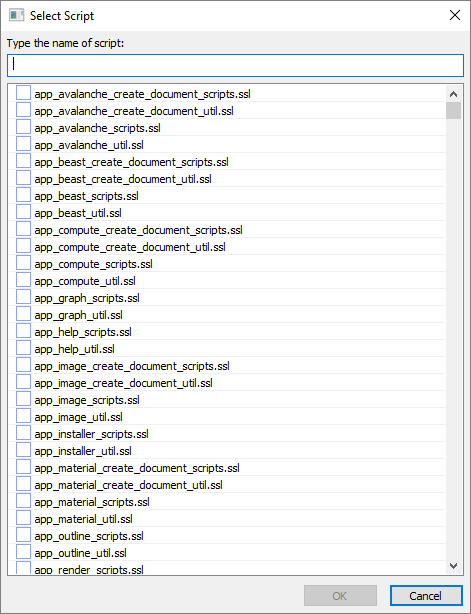Open the file.
There will be minor differences in your script and what you see below. For example: your macro GUID will be different from the GUID shown at the bottom of this script.
///////////////////////////////////////////////////////////////////////////////
//
// $author Scenomics LLC
// $description Implements commands for creating new Octopus documents.
//
// Copyright 2023 Scenomics LLC. All Rights Reserved.
//
///////////////////////////////////////////////////////////////////////////////
[Package="Simdify-Package-App-Octopus"]
import library "app_service_assert_util.ssl";
import library "app_service_console_util.ssl";
import library "app_service_create_document_util.ssl";
import library "app_service_file_util.ssl";
import library "app_service_generate_menu_util.ssl";
import library "app_service_main_util.ssl";
import library "app_service_message_box_util.ssl";
import library "app_service_shell_util.ssl";
import library "type_file_path_algorithms.ssl";
import library "type_node_buffer_algorithms.ssl";
import library "type_service_create_util.ssl";
import library "type_service_enumeration_util.ssl";
import library "type_str_list_util.ssl";
import library "type_str_util.ssl";
import library "app_octopus_create_document_util.ssl";
///////////////////////////////////////////////////////////////////////////////
// function
///////////////////////////////////////////////////////////////////////////////
function void GenerateMenu(
CommandBarEvent event,
string p_sCallback
)
{
string a_sGuid = "{9C47F182-D6D2-45C0-91C2-C38798DE5759}";
auto StrList a_slTitles;
auto Int32Array a_aiIndices;
auto TypeInfoArray a_aoTypes;
auto TypeArray a_aoItemImages;
int a_nCount = LibOctopusCreateDocument.PopulateMenu( a_slTitles );
a_aiIndices.SetCount( a_slTitles.GetCount() );
auto Int32ArrayAlgorithms a_aiAlgorithms;
auto Int32ArrayView src_view = a_aiIndices.GetView();
a_aiAlgorithms.Iota( src_view.First, src_view.Last, 0 );
a_aoTypes.AddTypeSequence( Node, a_nCount );
LibOctopusCreateDocument.GetIconImages( a_aoTypes, a_aoItemImages );
// Call the function that is going to
// populate our menu with items.
LibAppServiceGenerateMenu.BuildMenuFromInt32Array(
event.Bar,
-1,
a_sGuid,
Script,
p_sCallback,
a_slTitles,
a_aiIndices,
a_aoItemImages );
}
///////////////////////////////////////////////////////////////////////////////
// function
///////////////////////////////////////////////////////////////////////////////
function void AppOctopusCreateDocument_OnShowPopupMenu( CommandBarEvent event )
[HandleEvent="SPA.ShellUIEvents.ShowPopupMenu"]
{
CommandItem a_oItem = event.Bar.GetItemByText(
0, "CreateOctopusDocument" );
string a_sTitle = "&New";
if( a_oItem )
{
a_oItem.Text = a_sTitle;
a_oItem.IsPopup = true;
}
if( event.Bar.Title == a_sTitle )
{
event.Bar.RemoveAllItems();
string a_sCallback = "CreateOctopusDocument";
GenerateMenu( event, a_sCallback );
}
}
///////////////////////////////////////////////////////////////////////////////
// function
///////////////////////////////////////////////////////////////////////////////
function void CreateOctopusDocument(
ApplicationEventSource sender,
CommandExecutionEvent event,
string p_sMenuTitle,
int p_nIndex
)
{
if( p_sMenuTitle == LibOctopusCreateDocument.GetNewDocumentString() )
{
LibOctopusCreateDocument.Execute( event );
}
}
///////////////////////////////////////////////////////////////////////////////
// function
///////////////////////////////////////////////////////////////////////////////
function void CreateOctopusDocument_OnUpdate(
ApplicationEventSource sender,
CommandUpdateEvent event,
string p_sMenuTitle,
int p_nIndex
)
{
if( p_sMenuTitle == LibOctopusCreateDocument.GetNewDocumentString() )
{
event.Info.Status.SetHint( "Creates a new CPU/GPU workload document" );
}
}
///////////////////////////////////////////////////////////////////////////////
// macro
///////////////////////////////////////////////////////////////////////////////
macro AppOctopusCreateDocument()
[Category="Create Commands", Package="Simdify-Package-App-Octopus",
Guid="{9C47F182-D6D2-45C0-91C2-C38798DE5759}", Image=".\\icons\\generic_script_icon.bmp"]
{
// Stub to reserve the GUID and associate the image.
}
Let's review the contents of this script file.
Table 1.2. Script Contents
| Section |
Description |
| Header |
A brief description of the document. |
| Package Declaration |
Declares the package with which this script is associated. |
| Imports |
Library imports that allow us to call functions implemented in function libraries. |
| GenerateMenu |
This function is invoked by the function AppOctopusCreateDocument_OnShowPopupMenu, which is
the handler for popup menu events. This function populates the popup menu with menu items when the user selects the popup
menu in the user interface.
|
| AppOctopusCreateDocument_OnShowPopupMenu |
This function is the popup menu event handler. It scans the UI
during popup menu events and transforms command items with matching names into popup menus. First it changes the name
of the menu item from the stub text ('CreateOctopusDocument') to the menu item name seen by the user ('&New'), and then it calls GenerateMenu
to populate the menu with items.
|
| CreateOctopusDocument |
This function executes when the user chooses an item from the popup menu. In this case, we
only have one popup menu item. If we had additional popup menu items, this function would probably test the name of the
popup menu item and implement different behavior depending on which popup menu item the user selects.
|
| CreateOctopusDocument_OnUpdate |
This function controls whether or not the command is 'grayed out'. A command
that has been 'grayed out' is visible to the user in the interface, but it cannot be selected by the user. In general,
for this use case, we won't have any special filtering, but we will set the hint text that appears in the status bar when the user
mouses over the command.
|
| macro AppOctopusCreateDocument |
This macro implements a Simdify application command that can be installed in the
user interface. Like all Simdify application command macros, this macro must have a unique name and GUID. We are specifying the
generic script icon, which makes sure that this command has no associated icon when it appears in the user interface. NOTE: in
this case we don't want a command icon.
|
